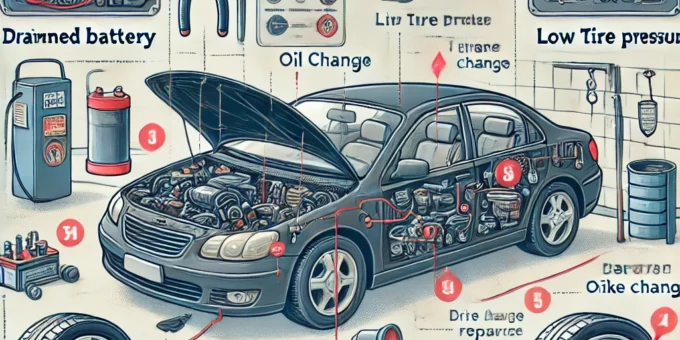
Every car owner eventually encounters maintenance issues, from squeaky brakes to a dead battery or mysterious engine noises. Knowing how to identify and fix these common problems not only saves time and money but also keeps your vehicle running smoothly and safely.
This guide will walk you through the most common car maintenance issues, how to diagnose them, and practical steps to fix them. Whether you’re a beginner or an experienced DIYer, these tips will help you stay prepared for everyday automotive challenges.
Why It’s Important to Address Maintenance Issues Early
Ignoring minor car maintenance problems can lead to:
- Costly Repairs: Small issues like a leaking fluid can cause significant engine damage if left unchecked.
- Safety Hazards: Faulty brakes, worn tires, or dim headlights can increase the risk of accidents.
- Reduced Efficiency: Issues like dirty air filters or underinflated tires can lower fuel economy and performance.
Pro Tip: Regularly inspecting your car and addressing issues promptly can save you thousands of dollars over the vehicle’s lifespan.
Tools You’ll Need for Basic Maintenance
Having the right tools on hand makes it easier to diagnose and fix car problems.
Essential Tools for DIY Maintenance:
- Socket set and wrenches
- Screwdrivers (flathead and Phillips)
- Jack and lug wrench for tire changes
- Multimeter for electrical diagnostics
- Tire pressure gauge
- OBD-II scanner for reading error codes
- Funnel and oil filter wrench for oil changes
- Work gloves and safety glasses
Issue 1: Dead Battery
A dead battery is one of the most common car problems.
Symptoms:
- The engine doesn’t start, or there’s a clicking noise when turning the key.
- Dim headlights or dashboard lights.
How to Fix It:
- Check the Battery Terminals: Look for corrosion and clean them with a mixture of baking soda and water.
- Jump-Start the Battery: Use jumper cables and a second vehicle or a portable jump starter.
- Replace the Battery: If the battery is over 3–5 years old, it may need replacement.
Issue 2: Flat or Underinflated Tires
Tires lose pressure over time or due to punctures.
Symptoms:
- Low tire pressure warning light.
- Uneven or rapid tire wear.
- A noticeable flat tire.
How to Fix It:
- Check Tire Pressure: Use a tire pressure gauge to ensure it matches the manufacturer’s recommendation (found on the driver’s door sticker).
- Inflate the Tire: Use an air compressor at home or a gas station.
- Replace or Patch: For punctures, use a tire repair kit or replace the tire if the damage is severe.
Issue 3: Brake Problems
Brakes are critical for safety, so don’t ignore unusual behavior.
Symptoms:
- Squealing or grinding noises when braking.
- A spongy or unresponsive brake pedal.
- Vibration when braking.
How to Fix It:
- Check Brake Pads: Replace pads if they’re less than 1/4 inch thick.
- Inspect Brake Rotors: Warped rotors can cause vibration and need replacement.
- Top Off Brake Fluid: Low fluid levels can affect brake responsiveness.
Issue 4: Engine Won’t Start
If your engine refuses to start, the issue could be related to the ignition system.
Symptoms:
- Clicking noise or silence when turning the key.
- Dashboard lights turn on, but the engine doesn’t crank.
How to Fix It:
- Check the Battery: Ensure the battery is charged.
- Inspect the Starter: A faulty starter may need replacement.
- Fuel Level: Ensure there’s enough fuel in the tank.
Issue 5: Check Engine Light is On
This light indicates an issue, but it doesn’t always mean a major problem.
Common Causes:
- Loose gas cap.
- Faulty oxygen sensor.
- Spark plug or ignition coil issues.
How to Fix It:
- Use an OBD-II Scanner: Plug it into the diagnostic port to retrieve error codes.
- Fix Simple Issues: Tighten the gas cap or replace faulty sensors.
- Visit a Mechanic: For unresolved or serious codes, consult a professional.
Issue 6: Overheating Engine
Overheating can cause severe engine damage if ignored.
Symptoms:
- Steam coming from under the hood.
- High temperature gauge reading.
How to Fix It:
- Turn Off the Engine: Let it cool before opening the hood.
- Check Coolant Levels: Refill the radiator with coolant if it’s low.
- Inspect for Leaks: Look for leaking hoses or a damaged radiator.
Issue 7: Unusual Noises While Driving
Strange noises can signal various issues.
Common Noises and Causes:
- Squealing: Worn brake pads or loose belts.
- Knocking: Low engine oil or damaged pistons.
- Rattling: Loose exhaust components.
How to Fix It:
- Inspect the area where the noise is coming from.
- Tighten loose parts or replace worn components.
Issue 8: Worn-Out Wipers or Poor Visibility
Clear visibility is essential for safe driving.
Symptoms:
- Streaks or smears on the windshield.
- Noisy or skipping wipers.
How to Fix It:
- Inspect Wiper Blades: Replace them if they’re cracked or worn.
- Clean the Windshield: Use glass cleaner to remove grime.
- Top Off Washer Fluid: Ensure the reservoir is filled.
Issue 9: Poor Fuel Economy
Reduced fuel efficiency can be caused by:
- Dirty air filters.
- Underinflated tires.
- Faulty oxygen sensors.
How to Fix It:
- Replace air filters and oxygen sensors.
- Keep tires properly inflated.
- Avoid aggressive driving and maintain steady speeds.
Issue 10: Electrical Problems
Electrical components like lights or windows may stop working.
Symptoms:
- Dim or flickering lights.
- Non-functioning power windows or door locks.
How to Fix It:
- Check Fuses: Replace blown fuses.
- Test Wiring: Use a multimeter to check for broken connections.
- Replace Bulbs: Install new bulbs for non-working headlights or interior lights.
When to Call a Professional Mechanic
Some issues are best left to experts, such as:
- Transmission problems.
- Timing belt replacements.
- Persistent check engine light issues.